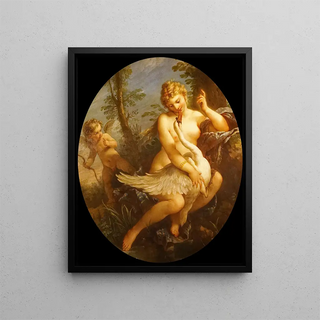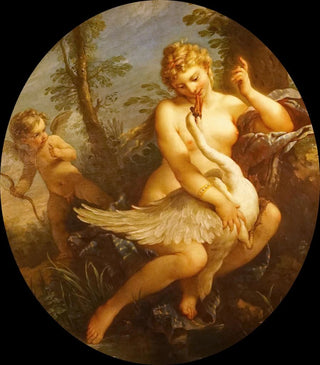Art print | Leda and the Swan - Charles-Joseph Natoire


View from behind

Frame (optional)
In the captivating world of French baroque art, "Léda et le cygne" by Charles-Joseph Natoire stands out for its elegance and symbolic depth. This iconic artwork, depicting the myth of Léda, the queen of Sparta, and Zeus transformed into a swan, invites viewers to immerse themselves in a mythological tale rich with emotion. The scene, both sensual and tragic, captures the very essence of beauty and the complexity of human relationships. Through this art print, the artist manages to convey an atmosphere of mystery and fascination, where the divine and the human meet in a timeless dance.
Style and uniqueness of the work
Natoire's style is characterized by remarkable finesse and mastery of colors that give his compositions a radiant luminosity. In "Léda et le cygne," the flowing drapery and delicate expressions of the characters reveal meticulous attention to detail, typical of rococo. The graceful curves of Léda's body intertwine with the form of the swan, creating a visual harmony that transcends the simple mythological narrative. The palette chosen by the artist, blending warm tones and soft shades, enhances the sensuality of the scene while evoking a dreamlike atmosphere. Every element of the composition, from the swan's feathers to the surrounding flowers, contributes to a captivating visual storytelling, reinforcing the idea that art is a powerful means of expressing human emotions.
The artist and his influence
Charles-Joseph Natoire, born in 1700, is a significant figure of the 18th century, whose work reflects a transition between classicism and rococo. Trained at the Royal Academy of Painting and Sculpture, Natoire established himself through his unique style and ability to capture moments of intimacy and beauty. His influence extends beyond his own creations, inspiring many contemporary and future artists. Through his works, he managed to incorporate narrative and symbolic elements that continue to fascinate art enthusiasts. "Léda et le

Matte finish

View from behind

Frame (optional)
In the captivating world of French baroque art, "Léda et le cygne" by Charles-Joseph Natoire stands out for its elegance and symbolic depth. This iconic artwork, depicting the myth of Léda, the queen of Sparta, and Zeus transformed into a swan, invites viewers to immerse themselves in a mythological tale rich with emotion. The scene, both sensual and tragic, captures the very essence of beauty and the complexity of human relationships. Through this art print, the artist manages to convey an atmosphere of mystery and fascination, where the divine and the human meet in a timeless dance.
Style and uniqueness of the work
Natoire's style is characterized by remarkable finesse and mastery of colors that give his compositions a radiant luminosity. In "Léda et le cygne," the flowing drapery and delicate expressions of the characters reveal meticulous attention to detail, typical of rococo. The graceful curves of Léda's body intertwine with the form of the swan, creating a visual harmony that transcends the simple mythological narrative. The palette chosen by the artist, blending warm tones and soft shades, enhances the sensuality of the scene while evoking a dreamlike atmosphere. Every element of the composition, from the swan's feathers to the surrounding flowers, contributes to a captivating visual storytelling, reinforcing the idea that art is a powerful means of expressing human emotions.
The artist and his influence
Charles-Joseph Natoire, born in 1700, is a significant figure of the 18th century, whose work reflects a transition between classicism and rococo. Trained at the Royal Academy of Painting and Sculpture, Natoire established himself through his unique style and ability to capture moments of intimacy and beauty. His influence extends beyond his own creations, inspiring many contemporary and future artists. Through his works, he managed to incorporate narrative and symbolic elements that continue to fascinate art enthusiasts. "Léda et le






